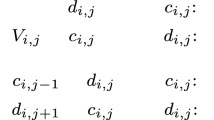Abstract
This paper deals with a strategic issue in the stable marriage model with complete preference lists (i.e., a preference list of an agent is a permutation of all the members of the opposite sex).
Given complete preference lists of all the men, a partial marriage, and complete preference lists of unmatched women, we consider the problem of finding preference lists of matched women such that the men-proposing Gale-Shapley algorithm applied to the lists produces a (perfect) marriage which is an extension of a given partial marriage. We propose a polynomial time algorithm for finding a desired set of preference lists, if these exist.
We also deal with the case that complete preference lists of all the men and a partial marriage are given. In this case, we consider a problem of the existence of preference lists of all the women such that the men-proposing Gale-Shapley algorithm produces a marriage including a given partial marriage. We show NP-completeness of this problem.
Similar content being viewed by others
References
Dubins, L.E., Freedman, D.A.: Machiavelli and the Gale-Shapley algorithm. Am. Math. Mon. 88, 485–494 (1981)
Gale, D., Shapley, L.S.: College admissions and the stability of marriage. Am. Math. Mon. 69, 9–15 (1962)
Gale, D., Sotomayor, M.: Some remarks on the stable matching problem. Discrete Appl. Math. 11, 223–232 (1985)
Gale, D., Sotomayor, M.: Ms Machiavelli and the stable matching problem. Am. Math. Mon. 92, 261–268 (1985)
Gusfield, D., Irving, R.W.: The Stable Marriage Problem: Structure and Algorithms. MIT Press, Cambridge (1989)
Kobayashi, H., Matsui, T.: Successful manipulation in stable marriage model with complete preference lists. IEICE Trans. Inf. Syst. E92-D, 116–119 (2009)
Knuth, D.E.: Mariages Stables. Les Presses de l’Universite de Montreal, Montreal (1976). An English translation by Martin Goldstein: Stable Marriage and its Relation to Other Combinatorial Problems. CRM Proceedings and Lecture Notes, vol. 10. American Mathematical Society, Providence (1996)
Roth, A.E.: The economics of matching: stability and incentives. Math. Oper. Res. 7, 617–628 (1982)
Roth, A.E., Sotomayor, M.: Two-Sided Matching: A Study in Game—Theoretic Modeling and Analysis. Cambridge University Press, Cambridge (1990)
Teo, C.-P., Sethuraman, J., Tan, W.-P.: Gale-Shapley stable marriage problem revisited: strategic issues and applications. Manag. Sci. 47, 1252–1267 (2001)
Tarjan, R.E.: Depth first search and linear graph algorithms. SIAM J. Comput. 1, 146–160 (1972)
Author information
Authors and Affiliations
Corresponding author
Rights and permissions
About this article
Cite this article
Kobayashi, H., Matsui, T. Cheating Strategies for the Gale-Shapley Algorithm with Complete Preference Lists. Algorithmica 58, 151–169 (2010). https://doi.org/10.1007/s00453-009-9359-3
Received:
Accepted:
Published:
Issue Date:
DOI: https://doi.org/10.1007/s00453-009-9359-3




